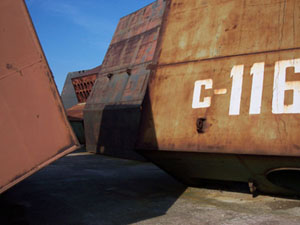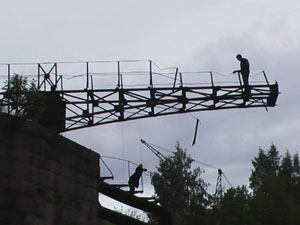
Interconnection :: life and art in a forgotten Russian town
by Gillian McIver, Luna-Nera
1 – Kronstadt – the arrival
As the crow or gull flies over Kotlin Island, its tiny eye will be puzzled about what it sees on the land below. On the right side of the island lies the town of Kronstadt. Or is it a town? From the air it looks more like the mechanistic workings of a giant clock or other device, vast in scale, but every part measured and fixed, purposeful and precise. A great machine carved into the landscape, surrounded by the straggly fixtures of a town.
In June 2004, we, the Luna Nera group of artists, made our second residency in the town of Kronstadt, a settlement founded in 1704 by Peter the Great on Kotlin Island in the Gulf of Finland. The aim of the residency was to continue our encounter with this unique urban space, and to make interventions in the landscape as well as to create a body of work for future exhibition.
Our first project, “Cross Encounters”, was about the initial encounter with the place. We had come to Kronstadt almost by accident, an invitation formed by chance meetings and unexpected coincidence. On our second visit we stayed longer, and attempted to dig deeper.
By the standards of most European settlements, Kronstadt is very new, only 300 years old, but has an astonishing amount of unique and significant marine architecture. Peter I (“the Great”) built Kronstadt as the most modern structure in the world, a showcase for military-naval architecture of its time. No expense was spared from the vast Imperial Russian coffers in its construction. The town was built around a complex system of canals and pools which ensured that provisioning, repairing and re launching of the ships could be done quickly and efficiently like a machine. The entire town served this process. For centuries it was the pride of the Russian navy, imperial and Soviet. Until the 1980’s the town boasted a Letniy Sad (summer garden) with a concert bowl for jazz and classical concerts and an underground ice house for cooling drinks and ice creams all summer long; clubs and concessions provided entertainment and leisure for all. In the late 1980’s big construction programs began to link the island to the mainland with a new bridge and with an underwater tunnel. But in 1989 everything suddenly just stopped.
A town of some 40,000 people, the official unemployment rate is 50%, but locals assert that the true figure is something like 70 or even 80%. Of course, many work in the city of St. Petersburg on the mainland. Until 1989 most people were involved in or employed by the military. Now most of these jobs have gone, only the naval school is hanging on. So the stark shock of change is still evident in the life of the community.
Until 1996, Kronstadt was a closed area to all foreigners,
and to most Russians. The fascinating Petrine-era and later architecture,
its vast naval storehouses and canals, its elegant palaces and exquisite naval
cathedral were known only in illustrations. However, now Kronstadt is in a
state of transition as the systems that supported and maintained its splendour
have disappeared.
Art as a means of regenerating moribund communities is an accepted practice
in the west (with mixed results) and had not been tried before in Russia.
Our mission in Kronstadt in both projects was not to create an exhibition,
or a permanent art space, but rather to create a creative atmosphere for art
practice, and to open the debate about the possible role of art in activating
interest in the local community.
2 - Interconnection – bringing contemporary art to Kronstadt
“Interconnection” attempted to explore trans-communication, bringing artists and local people together to create something new out of what was already there. The experience of being resident in Kronstadt was not an end in itself, but part of an ongoing process. Russian artists from St. Petersburg, Moscow and Nizhny Novgorod joined Luna Nera’s own international contingent (Canadian, German, Italian and British). Together we sought a unifying theme and jumping-off point from which to begin to look at this unique site.
We found our theme in radio. By sighting a plaque on the wall of one building, we found that Kronstadt was one of the sites where wireless communication was first created. Alexander Popov was a naval scientist who made the first known radio transmission, in Kronstadt in 1895. Followed soon after by Marconi and others, Popov could have had no idea that his efforts to create a system to rescue ships in distress would usher in a totally new era of media culture that would affect the entire world in a very short time. The theme of the project thus became “HOMAGE TO POPOV.”
During the residency we made audio art from field recordings of material collected in Kronstadt and St. Petersburg – conversations, explanations, medium and short-wave radio broadcasts, old recordings found in the flea market, the metro and taxibus, ships passing, and so on. Artist Eugene Strelkov collected audio waves from the Baltic Sea. And we explored the mysterious structures found all over Kotlin: the navy’s mechanical system of locks and channels; the cranes that have stood still for fourteen years; the enormous “cemetery” of marine detritus scattered on the shore; the necklace of sea forts offshore on tiny man made islands; the harbour bristling with warships; the military parade welcoming the new sailors to Kronstadt, and the 18th century fortress, used in the failed rebellion of 1921 and, more successfully, to keep the Nazi fleet from making a final assault upon St. Petersburg.
Immersion in the life of Kronstadt had its own issues. The Western artists were fascinated by its unique layout and architecture, while aspects of the living conditions were daunting. To the Russian participants, however, most incredible was actually working in this place, long known only from reputation and legend. Living our daily lives there was unusual too because it was White Nights, so the sun did not set, and all night long the island was awake and active, with people eating and drinking and strolling under the pink twilight sky.
(continued here)





"Russian Dialectic"
photo series by Julian Ronnefeldt